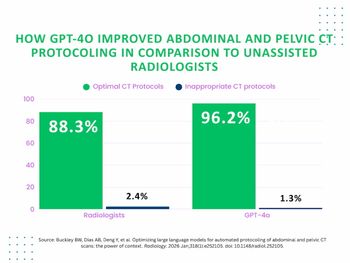
3-D MRI Helped Predict Survival in Liver Tumors
3-D MRI provides a lower error margin and allows radiologists to provide faster treatment advice.
Three-dimensional MRI may be a useful imaging modality for helping to measure living and dying tumor tissue as an indicator of the efficacy of chemotherapy in patients with liver tumors, according to the results of several studies presented recently at the Society of Interventional Radiology.
Senior investigator Jean-Francois Geschwind, MD, an interventional radiologist at Johns Hopkins, and colleagues said that the results are the first “proof of principle” that this technology can show tumors in three dimensions and accurately measure tumor viability and death.
“Our high-precision, 3-D images of tumors provide better information to patients about whether chemoembolization has started to kill their tumors so that physicians can make more well-informed treatment recommendations,” Geschwind said in a press release.
In the first study, the researchers looked at 17 patients with hepatocellular carcinoma who underwent transcatheter arterial chemoembolization and received functional, contrast-enhanced MRI within 90 days prior to tumor resection or liver transplantation. During the last scan a semi-automatic CD volumetric segmentation of the target lesions was performed and the researchers compared image analysis with pathologic review of tumor samples taken after therapy and surgery.
The error margin of the new 3-D image analysis was low (at up to 10 percent) when predicting the amount of dead tumor tissue found by pathologists, whereas the standard, 2-D method deviated by as much as 40 percent from actual values, according to the researchers.
The mean tumor necrosis was calculated as 81 percent for quantitative EASL and 84 percent for quantitative apparent diffusion coefficient. Both methods were significantly associated with tumor necrosis upon pathology.
Geschwind and colleagues conducted a series of additional studies that together looked at 123 patients with metastasis to the liver or hepatocellular carcinoma. Again, the researchers used 3-D MRI before and after treatment to evaluate the effects of the chemotherapy of the tumors.
A study of nine patients with melanoma and liver metastases showed that the mean percentage of volumetric tumor enhancement (qEASL) decreased from 63.9 percent to 36.5 percent in targeted lesions. The median survival of patients was 7.1 months; non-responders had a median survival of 4.8 months compared with 29.5 months among responders. qEASL was the only method to accurately predict survival among non-responders and responders.
Another study looked at 30 patients with unresectable colorectal cancer with metastasis to the liver who underwent conventional TACE or Y90 radioembolization with MRI before and after therapy. No significant difference in survival was observed for the two treatments. However, when the patients were stratified according to qEASL those patients who showed a response had an overall survival of 11.5 months compared with 7.0 months in non-responders.
Finally, an additional study presented at RSNA 2013 included 84 patients with hepatocellular carcinoma. Again, results showed that targeted tumor response and overall survival were significantly different between patients classified as responders and non-responders according to qEASL. Responders had a median overall survival of 42 months compared with 23 months in non-responders.
Geschwind says the 3-D technology’s improved accuracy removes a lot of the guesswork that now goes into evaluating treatment outcomes. The new assessment takes seconds to perform, he adds, so radiologists can provide faster, almost instantaneous treatment advice.
Geschwind and his team plan further software refinements to the new approach before training more physicians to use it. He also has plans to study how it can affect treatment decisions, and whether these therapy choices help people live longer.
Newsletter
Stay at the forefront of radiology with the Diagnostic Imaging newsletter, delivering the latest news, clinical insights, and imaging advancements for today’s radiologists.




























